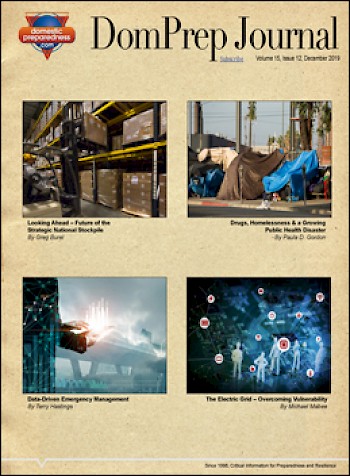
Publisher End Of Year Message 2019
Martin D. Masiuk
December 31, 2019
On behalf of the staff and many writers of DomPrep, I wish you a safe, healthy, and secure 2020. We
are about to finish our 21st year of publishing information for first responders, medical receivers,
emergency managers, local-state-federal authorities,

Looking Ahead – Future of the Strategic National Stockpile
Greg Burel
December 25, 2019
This year marks 20 years since Congress established the Strategic National Stockpile (SNS), originally named the National Pharmaceutical Stockpile, in preparation for the year 2000. The intent was to arm the country against possible terrorist threats that could disrupt the U.S. medical supply chain. With a $51 million appropriation and a handful of public health staff based at the Centers for Disease Control and Prevention, the stockpile began in 1999 with a sole focus to protect the American people from biological and chemical attacks.

Creating the Problem, Then Solving It
Catherine L. Feinman
December 25, 2019
It is interesting to stop for a moment and think, “How did we get here?” The emergency preparedness
and response profession has come a long way, offering emergency preparers, responders, and receivers
many more invaluable tools at their disposal than their counterparts had in previous years. Over time,
plans and procedures have adapted to ever-evolving needs and environments. And technology has advanced
beyond the imagination of their predecessors 50 years ago. However, for every advancement, a new
challenge(s) emerges.

Data-Driven Emergency Management
Terry Hastings, Patrick Campion and Mathew Curran
December 18, 2019
As the discipline has evolved, data and quantitative analytics are becoming a bigger part of emergency management. This trend is likely to continue as technology and data become more available. Current and future emergency managers need to understand data and how it can be used to support all phases of emergency management.

Drugs, Homelessness & a Growing Public Health Disaster
Paula Gordon
December 11, 2019
Conditions of squalor, which may be found in a refugee settlement or on the streets of a third world country, appear to be rapidly increasing in certain places in the United States over the past several years. This phenomenon is evident not only in a growing number of cities in California – including San Francisco, Oakland, San Jose, Los Angeles, and San Diego – but in cities in Oregon, Washington State, Colorado, and elsewhere. During the past several years, similar signs of deteriorating conditions have also become increasingly evident in New York City and Washington, D.C.

2019 National Preparedness Report
Domestic Preparedness
December 9, 2019
The National Preparedness Report evaluates annual preparedness progress and challenges facing the whole community. The 2019 National Preparedness Report highlights the diverse range of preparedness challenges the Nation faces—from terrorism

A Guide to Critical Infrastructure Security and Resilience
Domestic Preparedness
December 5, 2019
The U.S. Department of State and the U.S. Department of Homeland Security’s (DHS) Cybersecurity and Infrastructure Security Agency (CISA) developed this guide to serve as an overview of the U.S.

The Electric Grid – Overcoming Vulnerability
Michael Mabee
December 4, 2019
In 1850 – nine years before the Carrington Event and 12 years before the Civil War – the population of the United States was 23 million people. At the end of 2018, the population of the U.S. had reached 328 million people. What enabled the population to increase by 305 million people is quite simple: technology. New technologies that promoted this growth include: advances in medicine, advances in agricultural methods, the ability to transport food across the country (and across the world), new sources and uses of energy, an industrial revolution, advances in many areas of technology, and so on. All of these technologies are tied to one significant event: the advent of the electric grid.






